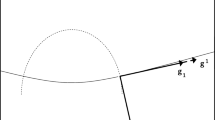Abstract
This paper considers the spatial elliptic restricted three body problem in the case that the particle with negligible mass is revolving around one of the primaries. The system is modelled in an inertial frame through a Hamiltonian function representing a non-autonomous dynamical system with three degrees of freedom that depends periodically on time. Three Lie transformations are applied at first order to eliminate successively the mean anomaly of the infinitesimal particle’s motion, the time dependence of the system and the argument of the node of the particle with negligible mass. All the transformations are implemented in a compact way, that is, carrying out the computations by means of infinite series. This approach can be very useful to deal with certain artificial satellite problems or, in general, with systems such that the ratio between the distance of the infinitesimal particle to the body around it orbits and the distance between the two primaries is smaller than one but close to it. In this case the Legendre expansion of the potential converges slowly and many terms of the series must be taken into consideration.

Similar content being viewed by others
References
Armellin, R., San-Juan, J.F., Lara, M.: Adv. Space Res. 56, 479 (2015). doi:10.1016/j.asr.2015.03.020
Astakhov, S.A., Farrelly, D.: Mon. Not. R. Astron. Soc. 354, 971 (2004). doi:10.1111/j.1365-2966.2004.08280.x
Broucke, R., Smith, G.: Celest. Mech. 4, 490 (1971)
Brouwer, D., Clemence, G.: Methods of Celestial Mechanics. Academic Press, New York (1961)
Brumberg, V.A.: Analytical Techniques of Celestial Mechanics. Springer, Berlin (1995)
Celletti, A., Chierchia, L.: Celest. Mech. Dyn. Astron. 95, 117 (2006). doi:10.1007/s10569-005-6215-x
Celletti, A., Chierchia, L.: Mem. Am. Math. Soc. 187, 878 (2007)
De Saedeleer, D.: Celest. Mech. Dyn. Astron. 91, 239 (2005). doi:10.1007/s10569-004-1813-6
Deprit, A.: Celest. Mech. 1, 12 (1969)
Deprit, A.: Celest. Mech. 26, 9 (1982)
Deprit, A.: Celest. Mech. 30, 181 (1983)
Goldstein, H., Poole, C.P., Safko, J.L.: Classical Mechanics, 3rd edn. Addison-Wesley, Reading (2002)
Golikov, A.R.: Cosm. Res. 50, 449 (2012)
Hansen, P.A.: Abh. Braunschw. Wiss. Ges. IV, 182 (1855)
Ito, T.: Adv. Astron. 2016, 8945090 (2016). doi:10.1155/2016/8945090
Kaula, W.M.: Astron. J. 67, 300 (1962)
Kaula, W.M.: Theory of Satellite Geodesy: Applications of Satellites to Geodesy. Dover, Mineola (2000)
Lara, M., Ferrer, S., De Saedeleer, B.: J. Astronaut. Sci. 57, 561 (2009)
Lara, M., Palacián, J.F., Yanguas, P., Corral, C.: Acta Astronaut. 66, 1022 (2010). doi:10.1016/j.actaastro.2009.10.011
Lara, M., Palacián, J.F., Yanguas, P.: AIP Conf. Proc. 1346, 73 (2011). doi:10.1063/1.3597588
Laskar, J., Boué, G.: Astron. Astrophys. 522, A60 (2010). doi:10.1051/0004-6361/201014496
Meyer, K.R., Offin, D.: Introduction to Hamiltonian Dynamical Systems and the \(N\)-Body Problem, 3rd edn. Springer, New York (2017)
Palacián, J.F., Yanguas, P., Fernández, S., Nicotra, M.A.: Physica D 213, 15 (2006). doi:10.1016/j.physd.2005.10.009
Sanders, J.A., Verhulst, F., Murdock, J.: Averaging Methods in Nonlinear Dynamical Systems, 2nd edn. Springer, Berlin (2007)
Szebehely, V.: Theory of Orbits. Academic Press, New York (1967)
Tisserand, F.: Traité de Mécanique Céleste. Gauthier-Villars, Paris (1899)
Vanegas, J.: Master thesis. Univ. Pública de Navarra, Pamplona (2011)
Winkler, C.: In: Proc. 9th Integral Workshop and Celebration of the 10th Anniversary of the Launch (INTEGRAL 2012). Bibliothèque Nationale de France, Paris (2012)
The Wolfram functions site. http://functions.wolfram.com/ (2017)
Acknowledgements
The authors have received partial support from Projects MTM 2008-03818 and MTM 2011-28227-C02-01 of the Spanish Ministry of Science and Innovation and Project MTM 2014-59433-C2-1-P of the Ministry of Economy and Competitiveness of Spain. We appreciate the remarks made by Drs. Víctor Lanchares and Martín Lara at some points of the manuscript.
Author information
Authors and Affiliations
Corresponding author
Appendix: Integrals of powers of sines and cosines
Appendix: Integrals of powers of sines and cosines
In this Appendix we describe how to obtain the integrals appearing in Sect. 3 to get the averaged Hamiltonians and the associated generating functions. We discuss three cases.
1. Case: \(\int (\cos x)^{2n+1}(\sin x)^{k}\,\mathrm{d}x\)
We make the change \(u=\sin x\), so \(\mathrm{d}u=\cos x\,\mathrm{d}x\), arriving at
Then, it is readily concluded that
and
The terms \((\sin x)^{2s+k+1}\) may be expressed as combinations of sines and cosines of multiples of \(x\) by using the following identities, see Wolfram (2017):
If \(p\) is even we can remove the term \(\frac{1}{2^{p}}\binom{p}{p/2}\) of the indefinite integral \(\int_{\text{pp}}\), as the constant terms will not affect the generating function.
2. Case: \(\int (\cos x)^{n}(\sin x)^{2k+1}\,\mathrm{d}x\)
We make the change of variable \(u=\cos x\). Thence, \(\mathrm{d}u=-\sin x \,\mathrm{d}x\) and therefore,
Thus, it follows that
together with
We may express \((\cos x)^{2s+n+1}\) as combinations of sines and cosines of multiples of \(x\), see for instance Wolfram (2017):
If \(p\) is even we can remove the term \(\frac{1}{2^{p}}\binom{p}{p/2}\) from the indefinite integral \(\int_{\text{pp}}\), as the constant terms do not affect the form of the generating function.
3. Case: \(\int (\cos x)^{2n}(\sin x)^{2k}\,\mathrm{d}x\)
In this case we do not need to perform any change of variable, since it is enough to put the powers of \(\sin x\) in terms of powers of \(\cos x\), or vice versa. Concretely we make
We express \((\cos x)^{2n+2s}\) as combinations of sines and cosines of multiples of \(x\) using (62), arriving at
Therefore, (63) is transformed into
from where we get
and
Rights and permissions
About this article
Cite this article
Palacián, J.F., Vanegas, J. & Yanguas, P. Compact normalisations in the elliptic restricted three body problem. Astrophys Space Sci 362, 215 (2017). https://doi.org/10.1007/s10509-017-3195-8
Received:
Accepted:
Published:
DOI: https://doi.org/10.1007/s10509-017-3195-8



